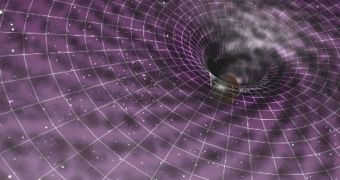The standard explanation of how our Universe is set up states that roughly one quarter (23 percent) of everything is made out of dark matter, a form of matter that cannot be readily observed through conventional means. In fact, it has never been observed at all, although scientists tried out a wide variety of methods for detecting it. But now, two experts advance a new role for dark matter that proposes the stuff altered the amounts of galaxies in the Universe, and that it did so to a significant margin, AlphaGalileo reports.
Astronomers Dr Xavier Hernandez and Dr William Lee, both of whom are based at the National Autonomous University of Mexico (UNAM), say that their study was prompted by their curiosity in learning how dark matter would interact with the supermassive black holes that form at the cores of impressively-large galaxies. The team says that its models provided them with a new basis for calculating both these interactions and the rate at which dark matter would get sucked in through the event horizon.
The group determined the existence of a threshold in these rates. If the immediate surroundings of the black hole are laden with dark matter in amounts higher than 7 Sun masses per cubic light-year, then the initial black hole was found to be capable of growing at extremely fast rates. Their investigation also revealed that, if such a growth spur was activated, then the black hole would be fueled even further by dark matter, eventually consuming the galaxy around it. If the galaxy would survive this ordeal, the group says, then it would be altered beyond any possible recognition when compared to its original shape.
“Over the billions of years since galaxies formed, such runaway absorption of dark matter in black holes would have altered the population of galaxies away from what we actually observe,” Hernandez says. The greatest implication of their analysis is the fact that the amounts of dark matter present at the cores of galaxies needs must tend for a constant value, if the entire structure is to remain stable. An additional implication is that dark matter may be behaving in ways previously not thought-of. This means that current models aimed at explaining its behavior – and which therefore underline efforts to find the stuff – may have to be thought over.

 14 DAY TRIAL //
14 DAY TRIAL //